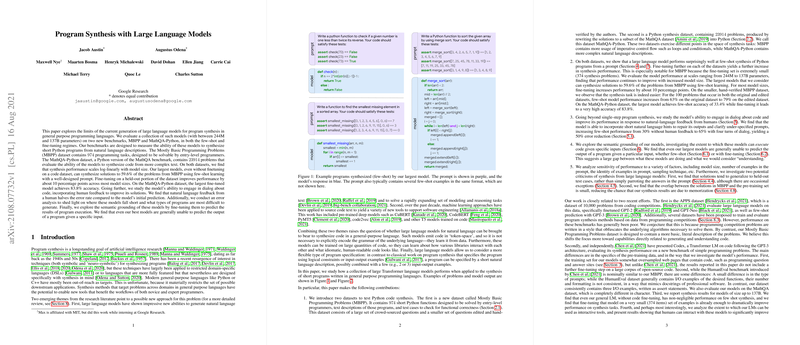Program Synthesis with LLMs: A Comprehensive Analysis
The paper "Program Synthesis with LLMs" explores the capabilities and limitations of contemporary LLMs in synthesizing code for general-purpose programming languages, with a specific focus on Python. This paper is essential for researchers interested in the intersection of NLP and software engineering, as it provides a detailed evaluation of the synthesis performance of LLMs under various conditions.
Summary of Findings
The research evaluates models of varying sizes, from 244 million parameters to 137 billion parameters, using two datasets: the Mostly Basic Programming Problems (MBPP) and the MathQA-Python dataset. The MBPP dataset consists of 974 programming tasks designed for entry-level programmers, while MathQA-Python contains 23,914 problems from the MathQA benchmark, adapted to Python.
Key Results
- On the MBPP dataset, synthesis performance scales log-linearly with model size.
- The largest models, even without fine-tuning on a code dataset, can synthesize solutions for 59.6% of MBPP problems using few-shot learning. Fine-tuning improves performance by approximately 10 percentage points across most model sizes.
- On MathQA-Python, the largest fine-tuned model achieves an impressive 83.8% accuracy.
The paper also investigates the model's ability to engage in dialog about code, incorporating human feedback to improve its solutions. Results show that natural language feedback halves the error rate compared to the model's initial predictions. Furthermore, an error analysis reveals the primary areas where these models fall short, providing insights into future directions for improvement.
Detailed Analysis
Performance on MBPP
The synthesis performance on MBPP reveals that LLMs are capable of generating correct code for a significant portion of tasks, particularly as model size increases. The 137 billion parameter model achieves a 59.6% success rate with few-shot learning, which underscores the potential of these models for practical code synthesis applications.
Strong Results
- Few-Shot Learning: The success rate in the few-shot scenario where the model is given only a few examples demonstrates the model's robust generalization capabilities.
- Fine-Tuning: Fine-tuning the LLMs on the MBPP dataset produces a substantial boost in performance, highlighting the importance of domain-specific training in enhancing model accuracy.
Challenges Identified
- Error Types: The paper categorizes errors into syntax errors, runtime errors, and semantic errors, with the largest model predominantly making semantic errors. This indicates that while the model can generate syntactically correct code, understanding and implementing the precise logic required by the task remains challenging.
- Sensitivity to Prompts: The model's performance varies significantly with different prompts, suggesting that high-quality, representative prompts are crucial for optimal performance.
Performance on MathQA-Python
MathQA-Python presents a different challenge with more complex natural language descriptions and fewer control flow constructs. The largest model achieves 83.8% accuracy when fine-tuned, showcasing the model's ability to adapt to new tasks with sufficient training.
Key Observations
- High Accuracy: The high accuracy on MathQA-Python illustrates the model's strength in translating natural language descriptions into correct Python code.
- Few-Shot vs. Fine-Tuning: The gap between few-shot and fine-tuned performance is more pronounced for MathQA-Python, suggesting that some tasks may inherently require additional training data to achieve high performance.
Human-Model Collaboration
One of the most intriguing aspects of the paper is the exploration of interactive capabilities of LLMs through human-model collaboration. The experiments show that natural language feedback from humans can significantly improve model performance.
Interactive Potential
- Error Reduction: Human interaction reduces error rates by 50%, demonstrating the potential of integrating LLMs into development environments where they can assist programmers by refining and correcting code in real-time.
- Example Interactions: The paper provides concrete examples where human intervention helps the model adjust its logic dynamically, underscoring the potential for synergistic human-AI coding collaborations.
Implications and Future Directions
Practical Implications
- Tools leveraging LLMs for code synthesis can streamline software development, particularly for tasks requiring boilerplate code or standard algorithms.
- Enhanced fine-tuning techniques could be developed to further bridge the gap between few-shot and high-accuracy performance, making LLMs more reliable for critical software engineering tasks.
Theoretical Implications
- The inability of LLMs to predict program output accurately without executing the code points to gaps in semantic understanding. This issue highlights an essential area for future research—embedding a deeper semantic model of programming languages within LLMs.
Future Developments in AI
- Improving model robustness, particularly in handling edge cases and more complex programming paradigms, will be pivotal.
- Research on combining symbolic reasoning with LLM-based synthesis could yield models that not only generate correct code more reliably but also understand and debug existing codebases.
Conclusion
The paper provides a comprehensive analysis of the current state of LLMs in program synthesis. It highlights both the promising capabilities of these models and the challenges that remain. The findings suggest a significant potential for LLMs to enhance software development through tools that assist in code generation, debugging, and optimization, while also pointing towards key areas for future research.
